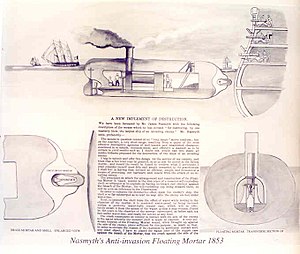 Naysmith Mortar (1853) Naysmith Mortar (1853)
| |
| History | |
|---|---|
| Name | Anti-Invasion Floating Mortar |
| In service | Never built |
| General characteristics (as designed) | |
| Length | 80 ft (24 m) |
| Beam | 30 ft (9.1 m) |
| Propulsion | Steam engine, single screw |
| Speed | More than 10 knots (19 km/h; 12 mph) |
| Armament | Explosive-filled ram |
| Armour | 10 ft (3.0 m) |
Also known as Naysmyth's Submarine Mortar and the Steam Ram, the Anti-Invasion Floating Hammer was a semi-submerged naval ship design conceived and published by inventor James Nasmyth in 1853.
About
The mortar had a length of 80 feet (24 m) and a beam of 30 feet (9.1 m) and was equipped with a small steam engine that drove a single propeller. The walls of the mortar were 10 feet (3.0 m) thick, protecting it against potential enemy gunfire of that period. At the front of the boat was a hollow brass cap shaped like a ram that was 9 feet thick. Inside the ram was a case filled with a heavy charge of explosive powder. With only the funnel and a domed structure covering the pilot being visible above water, the mortar sought to attack enemy ships by ramming the hull with the explosive-filled ram at speeds of over 10 knots (19 km/h; 12 mph). Because of potential dangers associated with its means of attack, the Anti-Invasion Floating Mortar was never built.
See also
References
- Smiles, Samuel, ed. (1912). James Nasmyth Engineer: An Autobiography. London: John Murray.
- Jackson, G. Gibbard (1930). The Romance of the Submarine. Philadelphia: J. B. Lippincott & Co.
- Newbolt, Henry (1918). A Note on the History of Submarine War. London: Longmans, Green & Co. p. 11. Retrieved 26 June 2012.